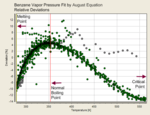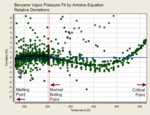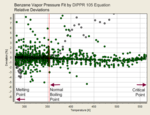User:Milton Beychok/Sandbox
The Antoine equation [1] is a vapor pressure equation and describes the relation of the saturated vapor pressure and the temperature for pure components. The Antoine equation is derived from the Clausius-Clapeyron relation.
The Equation
where is the Pressure, is the Temperature and , , are component specific constants.
The simplified form with
is named August equation, after the German physicist Ernst Ferdinand August (1795-1870). The August equation describes a linear relation between the logarithm of the pressure and the reciprocal temperature. This assumes a temperature-independent heat of vaporization. The Antoine equation allows a better but still insufficient description of the change of the heat of vaporization with the temperature.
An alternate form of writing Antoine's equation can be obtained by taking the logarithm in base 10 of both the sides. Hence, the equation becomes:
The Antoine equation can be transformed in a temperature-explicit form:
Validity Range
The Antoine equation can't be used to describe the entire saturated vapor pressure curve from the triple point to the critical point because it is not flexible enough. Therefore two parameter sets for a single component are commonly used. A low-pressure parameter set is used to describe the vapor pressure curve up to the normal boiling point and the second set of parameters is used for the range from the nomal boiling point to the critical point.
- Typical deviations of a parameter fit over the entire range (experimental data for Benzene)
Example Parameters
| A | B | C | T(min.) | T(max.) | |
|---|---|---|---|---|---|
| Water | 8.07131 | 1730.63 | 233.426 | 1 | 100 |
| Water | 8.14019 | 1810.94 | 244.485 | 99 | 374 |
| Ethanol | 8.20417 | 1642.89 | 230.300 | -57 | 80 |
| Ethanol | 7.68117 | 1332.04 | 199.200 | 77 | 243 |
The constants are given in °C and mmHg.
Example Calculation
The normal boiling point of Ethanol is TB=78.32 °C.
(760 mmHg = 101.325 kPa = 1.000 atm = normal pressure)
This example shows a severe problem caused by using two different sets of coefficients. The described vapor pressure is not continuous - at the normal boiling point the two sets give different results. This causes severe problems for computational techniques which rely on a continuous vapor pressure curve.
Two solutions are possible: The first approach uses a single Antoine parameter set over a larger temperature range and accepts the increased deviation between calculated and real vapor pressures. A variant of this single set approach is using a special parameter set fitted for the examined temperature range. The second solution is switching to another vapor pressure equation with more than three parameters. Commonly used are simple extensions of the Antoine equation (see below) and the equations of DIPPR or Wagner[2].
Units
The coefficients of Antoine's equation are normally given in mmHg and °C - even today where the SI is recommended and Pascal and Kelvin are preferred. The usage of the pre-SI units has only historic reasons and originates directly from Antoine's original publication.
It is however easy to convert the parameters to different pressure and temperature units. For switching from degree Celsius to Kelvin it is sufficient to subtract 273.15 from the C parameter. For switching from millimeter of mercury to Pascal it is sufficient to add the common logarithm of the factor between both units to the A parameter:
The parameters for °C and mmHg for Ethanol
A B C 8.20417 1642.89 230.300
are converted for K and Pa to
A B C 10.32907 1642.89 -42.85
The first example calculation with TB = 351.47 K becomes
A similarly simple transformation can be used if the common logarithm should be exchanged by the natural logarithm. It is sufficient to multiply the A and B parameters by ln(10) = 2.302585.
The example calculation with the converted parameters (for K and Pa )
A B C 23.7836 3782.89 -42.85
becomes
(The small differences in the results are only caused by the used limited precision of the coefficients).
Extension of the Antoine Equations
To overcome the limits of the Antoine equation some simple extension by additional terms are used:
The additional parameters increase the flexibility of the equation and allow the description of the entire vapor pressure curve. The extended equation forms can be reduced to the original form by setting the additional parameters D, E and F to 0.
A further difference is that the extended equations use the e as base for the exponential function and the natural logarithm. This doesn't affect the equation form.
Sources of Antoine equation coefficients
- The online Physical Properties Sources Index (PPSI) of the Swiss Federal Institute of Technology.[4]
- The online Dortmund Data Bank.[5]
References
- ↑ Antoine C. "Tensions des vapeurs; nouvelle relation entre les tensions et les températures", Comptes Rendus des Séances de l'Académie des Science, 107, 681-684, 778-780, 836-837; 1888.
- ↑ Wagner W., "New vapour pressure measurements for argon and nitrogen and an new method for establishing rational vapour pressure equations.", Cryogenics, 13(8), 470-482, 1973
- ↑ Nist Chemistry Web Book Enter chemical name, formula, CAS number or IUPAC identifier and then select "Phase Change".
- ↑ PPSI Antoine Constants
- ↑ Saturated Vapor Pressure, Calculation by Antoine Equation
- ↑ Carl L. Yaws (2007). Yaws' Handbook of Vapor Pressure: Antoine Coefficients. Gulf Publishing. ISBN 1-933762-10-1.
- ↑ John J. McKetta and William A. Cunningham (Editors) (1990). Encyclopedia of Chemical Processing and Design (Volume 36), 1st Edition. CRC Press. ISBN 0-8247-2486-0.
- ↑ R.C. Reid, J.M. Prausnitz and B.E. Poling (1987). The Properties of Gases and Liquids, 4th Edition. McGraw-Hill. ISBN 0-07-051799-1.
- ↑ {cite book|author=Ivan Wichterle and Jan Linek|title=Antoine vapor pressure constants of pure compounds|edition=|publisher=Praha, Academia|year=1971=id=}}



















